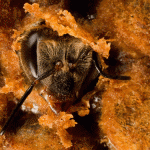
A sun-grazing comet was caught by SOHO's LASCO C2 camera as it dived toward the sun. Image credit: SOHO (ESA & NASA).
Its fiery end may answer questions about comets and the sun’s atmosphere.
On July 6, 2011, an ultra bright comet, from a group known as the Kreutz comets, could be clearly seen in the final stages of its life. It was filmed moving in over the right side of the sun before it evaporated in the heat 20 minutes later.
The un-named comet’s fate wasn’t a surprise, but the chance to watch it amazed astronomers. “Comets are usually too dim to be seen in the glare of the sun’s light,” Goddard Space Flight Center scientist Dean Pesnell said.
“We’ve been telling people we’d never see one in SDO (Solar Dynamic Observatory) data.”
Comet-watchers usually only see the Kreutz-group comets through images taken by coronagraphs, specialised telescopes that block direct sunlight with a solid occulting disk, allowing them to view the fainter corona. A new member of the Kreutz family is discovered every few days, but their evaporation as they near the sun has never before been witnessed.
Then on July 6, Lockheed Martin scientist Karel Schrijver spotted the bright comet in a coronagraph produced by the Solar Heliospheric Observatory (SOHO). To his surprise, he also found it in the SDO images.
Humans have been watching comets for thousands of years, but finding their dimensions usually requires a closer visit from a nearby probe. Watching the comets’ death allowed scientists to estimate its mass and size from afar, according to a study published in Science today.
They have estimated that it was 45 to 91 metres long, with a mass similar to that of an aircraft carrier. “Of course, it’s doing something very different than what aircraft carriers do,” Schrijver said.
“It was moving along at almost 400 miles (644 kilometres) per second through the intense heat of the sun ““ and was literally being evaporated away.”
There are a number of mysteries remaining from the comet movie and SDO are looking for more comets passing in front of the sun. So far, only this one has been spotted.
However, SDO did spot Comet Lovejoy travelling the corona, as it disappeared behind the sun and reappeared on the other side. And new sun-grazing comets appear every few days, so stay tuned.
Source: NASA.






